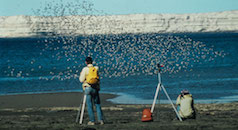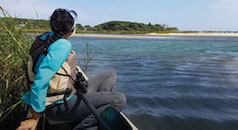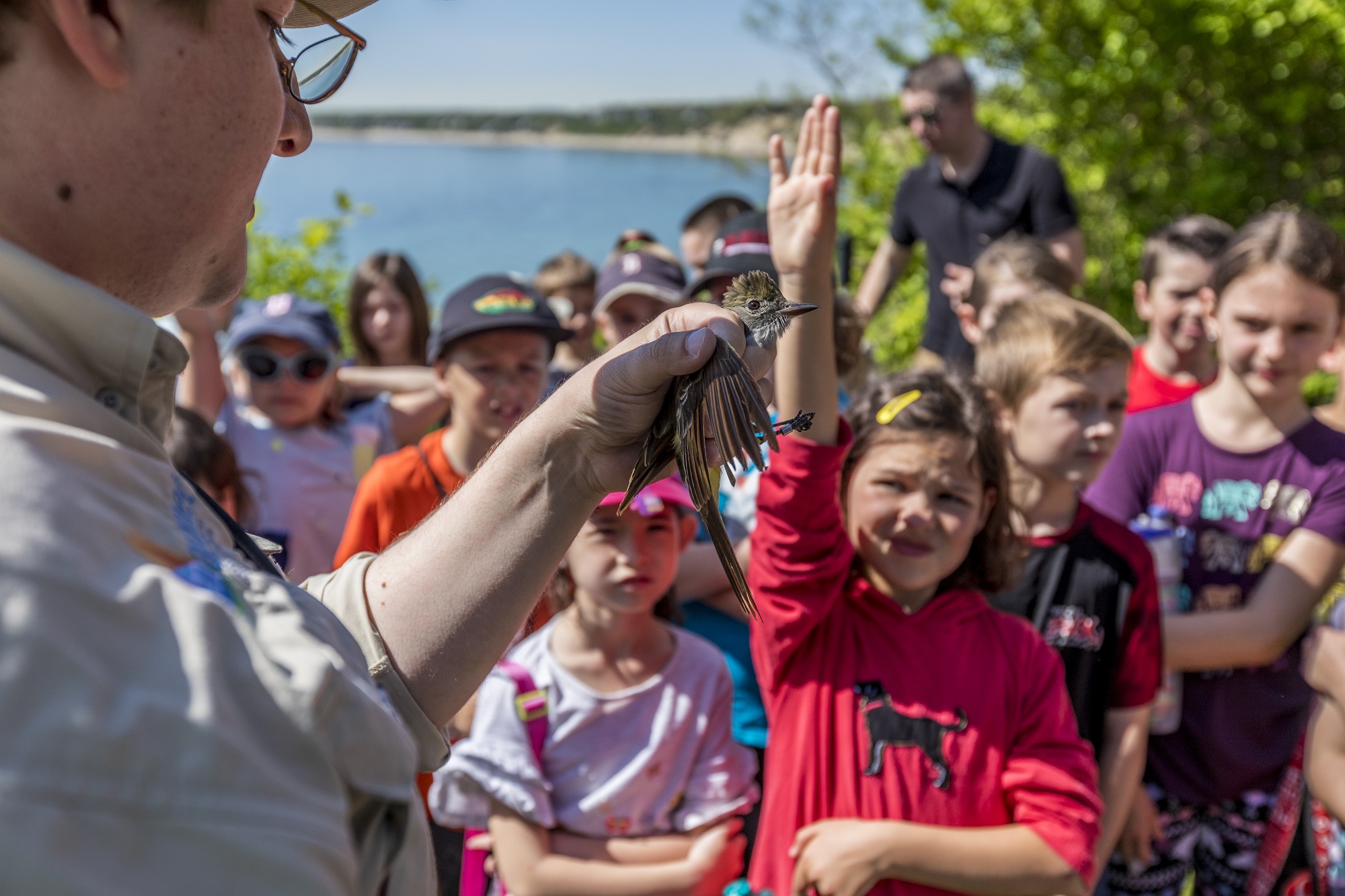Last year, Whimbrels carrying satellite transmitters captured the imaginations of many birders and nature enthusiasts.
The six-ounce birds, with names like Goshen, Machi, Chinquapin and Hope, garnered national news coverage by flying through and surviving Hurricane Irene. Chinquapin, in particular, was featured on ABC News and in the pages of USA Today.
Manomet’s Brad Winn, a conservation specialist with the Shorebird Recovery Project, banded Chinquapin in May 2010 while working for the Georgia Department of Natural Resources.
“We captured Chinquapin at about midnight on May 22 when he came in with several hundred other Whimbrels to a night-roost on Georgia’s barrier coast,” Winn said. “The soft flute-like contact calls of the birds that were landing all around us in the dark that night were magical. I will never forget that sound.”
For many years, Winn and his colleagues had observed thousands of Whimbrels using tiny offshore sand spits in Georgia as overnight roost sites every year between early April and the third week in May. Georgia and Virginia appear to be major staging areas for Whimbrels, where they stay for several weeks and put on enough fat and muscle to double their body weights. During the day, the birds would descend into the saltmarshes to feast on fiddler crabs, an almost limitless food supply where healthy saltmarsh exists. The birds were clearly using many coastal habitats, not just Georgia’s extensive saltmarsh during the day for feeding. Single birds that had been stuffing themselves with tiny crabs all day would join flocks late in the day to rest and preen in marsh openings and on shell rakes. As darkness fell, Whimbrels could be seen flying to remote sand spit islands until sun rose again.
What habitats are most critical for a Whimbrel during migration? How long will they travel from night roost to daytime feeding sites. How many fiddler crabs does a Whimbrel need to gain enough weight to continue migration? For a biologist like Winn, responsible for maintaining populations of a state’s bird species, these are all important questions.
Winn began collaborating with a number of organizations to continue research into the flight paths of these shorebirds and others, investigating how long they stay at staging areas and locating other important ones, finding breeding and wintering sites, and identifying the threats to their existence. At the time, there was no technology to trace a Whimbrel’s travels throughout a year over vast landscapes.
Once the technology was developed to track the birds, the team started recording avian feats of endurance, such as nonstop flights of great distance and travel through hurricanes. To track a bird a scientist must first catch it and then dress it in a tiny harness carrying a lightweight device (a “tag”) combining a solar panel to provide power and a transmitter to convey signals to a satellite. The tagged bird is released unharmed to act as a representative of those of its kind and guild, transmitting vital information as it flies.
“Each tagged bird is, of course, an individual, but as a member of a highly gregarious species that travels much of the time in larger flocks, it can inform us of what many Whimbrels are doing,” Winn said. “It appears that Whimbrels rely on very specific areas for staging, breeding and wintering, and will return to these areas year after year. By identifying these locations in various countries, we can tie into the Western Hemisphere Shorebird Reserve Network, and work to protect the areas thus reducing land-based threats to the birds.”
Sometimes, however, a Whimbrel must alter its course and set down on land to replenish its energy reserves after a stressful, energy-depleting flight, such as those through storms. The Whimbrels named Machi and Goshen, originally tagged on Virginia’s Eastern Shore by Winn’s colleagues at the Center for Conservation Biology at William and Mary, and Barry Truitt of the Nature Conservancy, demonstrated this behavior recently. Before his final flight, Machi was tracked for over 27,000 miles back and forth between breeding grounds in the Hudson Bay lowlands of Canada to wintering grounds on the coast of Brazil. He also racked up seven nonstop flights of more than 2,000 miles.
During the spring of 2010, Machi flew more than 3,400 miles directly from Brazil to South Carolina. Last August, Machi flew through Tropical Storm Maria and landed on the island of Montserrat, then moved to nearby Guadeloupe Island. Goshen, a female, traversed Hurricane Irene’s outer bands and landed on Antigua before flying to neighboring Guadeloupe. Researchers assume that both birds needed to rest and feed before resuming their flights to wintering grounds on the coast of Brazil.
Hunters on Guadeloupe shot both Machi and Goshen on August 12 2011.
Goshen and Machi illustrate what birds are capable of – flights of incredible endurance, survival in storms and careful navigation to exact locations. They also demonstrate the area in which they need assistance from us in order to survive in the future: protection from human-caused stresses, whether it is hunting, human disturbance or habitat destruction.
“As conservationists, we need to take the highly publicized shooting losses of Machi and Goshen and draw international attention to all of the issues that threaten entire shorebird populations, like the steady loss of coastal wetlands around the world,” Winn said. “Whimbrels are one small part of a very complex migration story involving dozens of shorebird species. We are working hard at Manomet to understand all the pieces to this incredible living puzzle.”





 Back to all
Back to all